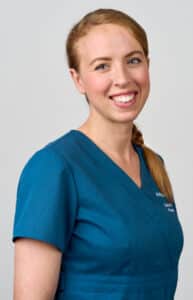
Laura Allmark
MSc (Vet Phys) BSc(Hons) MNAVP
Head of Physiotherapy
Laura is a Veterinary Physiotherapist who qualified from Harper Adams University in 2014. Her Master’s thesis established a strong professional interest in post-surgical rehabilitation and investigated current post surgical physiotherapy protocols for dogs with cruciate disease.
Laura is a member of the National Association of Veterinary Physiotherapists (NAVP) and has full professional and public liability insurance. The NAVP is recognised by most pet insurance companies and ensures that members maintain their professional development with the latest clinical evidence. NAVP members are therefore able to provide the best possible treatment for your pet. Laura sits on the executive committee for the NAVP which enables her to impact the development of the profession and improve standards within the association.
Veterinary physiotherapists undergo extensive training in the assessment and treatment of injured and lame animals, making them experts in the biomechanics of animal movement. Laura offers skilled, patient and compassionate rehabilitation in a variety of forms and settings and is passionate about engaging owners in their pet’s rehabilitation.
A typical day for the team at AMVS is that they generally have two veterinary physiotherapists in each day supported by an experienced assistant to help with animal handling. Their day starts with morning rounds where a senior wards nurse hands over how our patients have been overnight, and they discuss the plan together for each patient that day. One of the team will look after the inpatient cases and assessing and treating each case, producing rehabilitation plans, and for those going home – coordinating discharges and preparing their home rehabilitation plans following surgery.
The majority of the Neurology and Orthopaedic cases are discharged with a Veterinary Physiotherapist where appropriate, and this ensures that owners are comfortable with what they have to do for their pet’s rehabilitation. We take great pride in ensuring our patients have a positive experience with us, and working with the AMVS Patient Experience Team, we have developed strategies and techniques to ensure that each patient’s time with the Physiotherapy service is as stress free as possible – which is why a lot of patients find their appetite with us in the Physiotherapy room!
The Veterinary Physiotherapist seeing our outpatients that day, will have a list of appointments for patients either referred directly from vet practices (typically for assistance in managing osteoarthritis and mild cases of hip or elbow dysplasia) or those returning to AMVS following either orthopaedic or spinal surgery/injury. During these appointments we review their history and assess each patient for areas of discomfort, restriction, and musculoskeletal dysfunction. Clinical reasoning and informed interpretation are the required basis for any intervention with the aim of reducing pain, improving movement, and restoring normal muscle control and function. This can be achieved with a combination of manual therapies (massage and soft tissue techniques, joint mobilisations, stretches etc.), electrotherapies (Class 4 Laser, TENS, therapeutic ultrasound etc.), and remedial exercises utilised to correct movement patterns and improve muscle strength, endurance, suppleness, proprioception and balance; and management advice.
Laura shared with us her early days to show what sparked a passion for helping animals recover and pursue her studies in this field, even before Veterinary Physiotherapy was a profession.
She said “It’s a funny story– growing up we had a rabbit who became paralysed in his pelvic limbs following fly strike. We all said our goodbyes and my father took him to our vets to have him put to sleep. However, the vet thought that as he was young and healthy, he could have a good quality of life. So he returned home and I spent every evening massaging his legs, bicycling them round and helping him to his feet as he hopped around our kitchen. He made a full recovery and lived a long and happy life as our house rabbit.”
Even today many years later Laura says the best part of the job is making a difference to pets. She said “Seeing pets get better is so rewarding and – for an animal lover – I actually really enjoy the working relationship that develops between myself and the owner during the rehabilitation period. I have a particular penchant for our golden oldies – and while they may never get ‘better’, I have seen time and time again the difference our skills can have on their comfort levels and quality of life, and I have yet to meet an owner who isn’t grateful for the extra time that has given them with their beloved companion.”
Outside of work, Laura is a passionate horse rider, and enjoys preparing her horse Stanley for eventing and riding club competitions. She also enjoys spending time exploring the UK with her young family in their campervan – always accompanied by her two lurchers, Jack and Pumpkin – Pumpkin is a rescue and she only has 3 legs!
Laura said for anyone wanting to pursue a career in Veterinary Physiotherapy, the most important skills you can develop are your observational and animal handling skills. Spending lots of time watching animals move – dogs at agility, young dogs at puppy parties, horses being schooled, cats hunting, even the giraffes at your local zoo. And then seek out opportunities to develop your animal handling skills as you will need to confidently handle everything from a rabbit to a cow – it’s not just dogs and cats!